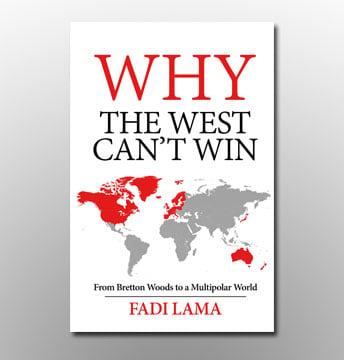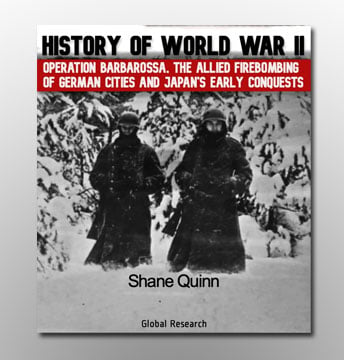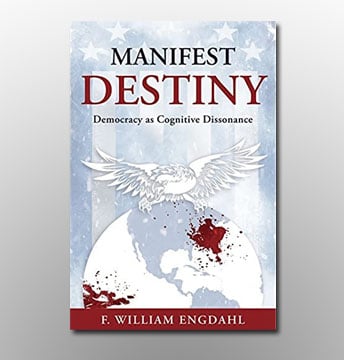All Global Research articles can be read in 51 languages by activating the Translate This Article button below the author’s name.
To receive Global Research’s Daily Newsletter (selected articles), click here.
Follow us on Instagram and Twitter and subscribe to our Telegram Channel. Feel free to repost and share widely Global Research articles.
***
There can be no acceptable future without an honest analysis of the past. — Aleksander Solzhenitsyn
In high school we were taught that capitalism refers to an economic system comprised of privately run for-profit companies that sell products and/or services. We learned that, whether its stock is privately held or traded on a public exchange, a capitalist enterprise has, generally speaking, a relatively small number of people (owners, a board of directors, senior management) who function as the employer and a relatively large number of people who function as the employees.
The employer pays a salary or wages to the employees for their labor, including their ideas, but all the final decisions—how, what, and where to produce the goods and, most importantly, what to do with the profits—are made by the handful of employers at the top. The entire capitalist model is based on a hierarchical system wherein a small minority has complete authority over the majority.
In the capitalist system, the wage the employer pays to the employee will always be of less value than the worker’s labor plus the other inputs used during the entire production process. In other words, to make a profit the employer must pay the worker less than the surplus income his labor generates. The higher the surplus, the more competitive the company is in its industry. By contrast, the employee wants higher wages—wants to increase his standard of living. Therein lies the struggle between employer and employee. Ever since capitalism’s inception, that conflict has always been a source of tension between the two opposing sides.
Capitalism comes in several variations, but the one constant is the unequal employer-to-employee relationship. That unequal relationship exists in state-controlled capitalism—found, for instance, in the communist countries of China, Cuba, North Korea, Vietnam, and the former USSR—as well in as the democratic-socialist countries of Scandinavia. It also exists in so-called capitalist countries, in which privately held businesses operate under an economic system variously labeled free market, free trade, free enterprise, corporate, shareholder, or laissez faire. Each type falls under the umbrella of capitalism.
Therefore, regardless of the brand of capitalism, all forms of it are inherently autocratic: The employer owns the means of production and has final—if not exclusive—say in all business decisions. In sum, capitalism’s built-in designrequires inequality.
These days you’ll often hear the expression “crony capitalism” bandied about. In fact, it’s a deceptive term, for it leads one to think there’s such a thing as “good capitalism” and “bad—crony—capitalism.” In reality, they are one and the same.
The Cooperative Model
There is, however, another economic model that most of us never hear mentioned in high school or college and that even in our adult years we rarely, if ever, learn about: the “cooperative.” A cooperative is a special type of corporation that places ownership and control of the corporation in the hands of the employees. In a cooperative—and only in a cooperative—there exists, not an employer-versus-employee relationship but an employer-and-fellow-employer mutuality. What this means is that all of the workers, from bookkeeper to janitor, own the means of production. They are all employers. They have no employees working for them—that is, under them.
We will call the cooperative’s workers “employees” simply because that word is more understandable in the context of this article.
Being non-hierarchical, the cooperative system gives everyone an equal voice in the decision-making process. When it is time to make a collective decision, every employee has one voting share, referred to as a membership share. The share represents the employee’s ownership of the cooperative. Regardless of professional position or personal wealth, each employee may own and exercise only one voting share. No employee can buy or control the share of another employee. In other words, all personnel in a cooperative function as their own board of directors, each with an equal voice in the decision-making, whether they are hiring a new administrator or conducting day-to-day operations.
By contrast, in a traditional capitalist model (sometimes referred to as shareholder capitalism), the workers do not own the enterprise. (They may own a portion of the shares, but that right gives them neither ownership nor a major influence on their company’s board of directors.) There are usually three classes of shares: Class A voting shares, held by regular investors; Class B voting shares, held by the company’s founders; and Class C shares, normally held by the employees. Class B shares typically do not trade in the open market, whereas Class A shares trade, but Class B shares have ten times the voting power of Class A shares. Class C shares have no voting rights, but still trade in the open market. For instance, Alphabet, Google’s parent company, issues Class A shares and Class C shares. Both classes trade in the market, with negligible difference between the two share prices.
In a capitalist-run corporation, if a wealthy shareholder or a group of shareholders buys up the majority of the voting shares, they will have the majority of the voting power when choosing a new CEO or electing new members to the board of directors or voting on other key issues that determine the company’s destiny. The entire process doesn’t even remotely resemble an egalitarian way of organizing a business structure.
Stakeholder Capitalism
As if shareholder capitalism were not problematic enough, the World Economic Forum (WEF) has of late been foisting on the world the concept of “stakeholder capitalism.” In stakeholder capitalism, either a single unelected and unaccountable individual or a group of unelected and unaccountable individuals—they could be vendors or customers or even community activists—get to decide if a company is fulfilling its obligation to live by sustainable environmental, social, and governance (ESG) practices. By embracing ESG metrics such as diversity and inclusivity, among other measurements, a company can get a favourable score, enabling it to receive future investments and bank loans. Naturally, the opposite happens if a company refuses to report or comply with the WEF’s ESG standards. It could be boycotted and deprived of all future investments, thereby ensuring its demise. In short, the intellectually bankrupt concept of ESG is nothing more than a thinly veiled deception employed by social engineers to gain control of companies and their assets.
Although no consolidation between two cooperative-run corporations has ever taken place, it might be instructive to outline how the process would be carried out if there ever were such a merger. First, the workforce from both companies would have to vote on whether combining the two cooperatives would be acceptable to them. Unlike capitalist mergers or acquisitions, where layoffs are common—sometimes affecting thousands of workers—in a cooperative merger, all employees must be retained. The wealth from the combined entity would be distributed evenly throughout the workforce. The CEO would have no more earnings or influence after the merger than before it. The top salary would still be capped up to a maximum of four times that of the lowest base wage in the firm (or whatever ratio the employees, through a vote, have agreed upon). The CEO would never earn ten times—much less 1,000 times—more than the cooperative’s lowest wage earner.
Incidentally, in a cooperative, the CEO and the other executives work for the employees, who are technically the CEO’s employers! I say this because managers with a particular skill set or type of expertise are often brought into a cooperative from the outside. No matter how senior a manager’s position may be, if his performance is subpar he can be removed at any time by the employees (his employers) in a vote of no-confidence.
In stark contrast, after a merger between large companies in the capitalist system, their senior managements use the combined entity’s swelled size and wealth to exert more control, more clout, not only over the remaining employees but also over their external surroundings—that is, the political, social, and economic milieu.
Put another way, companies that are capitalist behemoths are apt to flex their enlarged, “merged” muscles—often in bullying, despotic fashion. The lesson: Concentrating affluence and influence in the hands of a small minority, whether in large corporations, big banks, centralized governments, or, really, any institution, tends to widen and deepen already existing inequalities throughout the entire structure of a society.
This intrinsic tendency of capitalism to narrow the field of companies while simultaneously creating enormous enterprises—thereby reducing industry competition—is why in every capitalist economy the federal government is eventually called upon to pass antitrust laws that prevent monopolization. Small-to-mid-sized businesses simply cannot compete and thus cannot survive in such an environment.
Granted, the capitalist production system does temporarily provide more efficiency in some areas. However, that efficiency is eventually offset by a creeping accumulation of power, which serves a nation’s ruling class well while undermining all other social and economic classes. So, we have the ruling class both creating and benefitting from massive mergers and acquisitions.
The capitalist system that came to the fore in late nineteenth-century America and that rose in prominence and power in the twentieth century is so potent today that it controls, to one degree or another, all levels of government and all levers of power. This paradigm holds true not just for the American Empire but for almost all nations that are home to capitalism. Consequently, any perceived notion of democracy we once had in the West is now nothing more than an illusion.
The Origin of Democracy
I say “perceived” because the original meaning of “democracy,” as envisioned by the ancient Greeks, has long since been reduced to a meaningless slogan. As we may recall, the word “democracy” (demokratia) derives from the Greekdemos, meaning “people , ” and the Greek kratos, meaning “power.” Literally translated, it means “people power.”
Yet when we read Aristotle’s writings about earlier Greeks, we discover that he never once mentioned Cleisthenes and his remarkable achievements. Why is that? Probably because, as we said above, Aristotle was a member of the establishment and as such couldn’t abide the thought of future generations of young minds learning about—or even organizing—a government that would upset the privileged positions of power that the parasitic ruling class enjoyed.
The Pretense of Democracy
Though we in the West have been indoctrinated by our government schools to believe that capitalism and democracy thrive together and cannot survive without one another, in fact just the opposite is the case. All forms of capitalism are completely incongruous with all forms of democracy—direct, representative, presidential, parliamentary, participatory, social, and Islamic.
Indeed, capitalism and democracy can coexist only temporarily. Capitalism’s inevitable dysfunctions—undemocratically run enterprises, extreme concentration of wealth and power, unequal distribution of goods (resulting in artificial excess and scarcity), and public-private partnerships (creating unholy alliances between capitalists and government officials)—become manifest in, and eventually erode, any well-intended brand of democracy.
Thus, no matter how noble the aims of some of the American Founding Fathers in creating a constitutionally limited representative democratic republic, that republic was, by the end of the nineteenth century, barely functioning. Granted, representative democracy may have still been working at municipal and county levels, but at the state and national levels it had become nothing more than an illusion.
Today, the United States “republic”—such as it is—and other so-called Western democracies are under attack by a global financial oligarchy. Intertwined with and embedded in the WEF and its parent, the United Nations, these financial oligarchs forward a neo-Malthusian depopulation agenda that targets all of humanity.
Ironically, capitalists who give lip service to the idea of “democracy” and pretend it actually exists in politics have never allowed “democracy” in the workplaces they own, control, and amass personal fortunes from. Why not? Surely it is because they recognize that the deprivations, inequities, bought-and-paid-for politicians, and ecological disasters that plague the world today are natural outgrowths of the unaccountable power wielded by the privileged few at the top of global capitalist-run organizations.
In short, by not democratizing the economy and its means of production, a political system that calls itself a representative democracy or any other kind of democracy can never stand the test of time. The autocratically run,undemocratic institutions that make up its economy will eventually dominate that nation’s political and economic spheres.
Put another way: Any nation, without exception, that utilizes the capitalist economic system has always succumbed and will continue to succumb to the aforementioned erosion in democracy at the state (or provincial) and national levels of politics.
The Grand Deception
The federal election process in the West also deserves a few words. Just because registered voters can go to a ballot box every two or four or six years to cast a vote for plutocrat A or oligarch B does not mean they live in a free country or have equal representation or guaranteed rights. Citizens of Western countries are programmed from childhood to believe that they are choosing between ideological dualities, when, in reality, they are merely choosing between two sides of the same coin, which is minted by their masters. This is the grand deception of the two-party or multi-party paradigm.
Clued-in contemporary authors, pundits, and documentary filmmakers have opined that we are living in a time when the leadership of many nations is compromised. In saying this, they mean that individuals are placed in positions of power—as president, prime minister, or chancellor—based on whether they can be influenced and even silenced, notbased on their meritorious character, leadership skills, or statesman-like wisdom. It should be noted: Although this is an accurate assessment of the twenty-first century, the phenomenon of “captured” politicians and their bureaucrat lackeys is hardly new. It has been well underway in American politics since the end of the nineteenth century—and in older nations throughout all time.
Elections have become—if they were not always—merely a stamp of approval given by deceived voters to candidates who have been pre-selected for political office by an exclusive coterie of money men. More precisely, these money men are members of an alliance of billionaire, supranational, multigenerational families. They profess undying devotion to free enterprise, to their countrymen, and to the so-called democratic process. But in reality they are loyal only to themselves and their clan. It’s not surprising that they are beholden to money and power, for they have been taught from birth that enormous wealth and outsized influence are rightfully theirs, based on their bloodlines, their genes, their smarts, and their self-deluded belief in their godlike status. They are what we might call global financial oligarchs.
These supposedly superior human beings are behind Big Everything: Big Government, Big Capital, Big Industry, Big Science, Big Pharma, Big Military, Big Agriculture, Big Intelligence, Big Media, Big Academia, Big Entertainment—behind anything and everything that enables them to retain their presumed authority over, even ownership of, the rest of the human race—and, indeed, over all the earth. Any thought they have, word they utter, or move they make is in support of their will, their wealth, their comfort, their control—all with the intention of making subservient or physically annihilating everything and everyone else.
The global financial oligarchy’s lust for control has in this era wed itself to technology and pseudoscience as a means of engineering society into a scientific dictatorship, aka technocracy. Their diabolical plan, which is already well underway, is designed to eradicate representative democracy, sovereign nation-states, and individual liberties, not to mention small businesses, national currencies, and cash. The end goal of this global technocratic dictatorship is to control, commodify, digitize, and financialize absolutely everything on earth—including nature and human beings’ bodies and minds.
In ancient Egypt, in the Roman Empire, and in many other early civilizations, the wealth of a nation resided in the hands of a few families, and it has remained in the hands of these ruling family dynasties ever since. In the nineteenth century, they bore prestigious names like Morgan, Rothschild, Rockefeller, Carnegie, Schiff, Warburg, Loeb, DuPont, House, Saxe-Coburg and Gotha (the British Royals).
Today, those same dominating, power-craving, status-seeking men and women—and their descendants and protégés—are steering humanity towards a neo-feudal dystopia. These privileged individuals—and their associated societies/councils, news outlets, Wall Street/City of London financiers, philanthropic organizations, universities, and think tanks—operate, entirely apolitically, behind the scenes. They lurk in the shadows of government offices and in other halls of power, always designing ways to subvert the popular vote and steal the property, liberty, happiness, health, welfare , and every God-given right of all people.
With most of the world now peering into the jaws of the technocrats’ nightmarish “Great Reset” and their equally spine-chilling transhumanist agenda, it is time to peacefully organise and find new alternatives to our broken economic paradigm. The cooperative model, which I described above, is already taking hold on a global scale. There are, at present, millions of people organising cooperatives around the world.
For instance, twelve percent of humanity is currently part of three million cooperatives dotting the earth. As of 2020, ten percent of the planet’s employed population was involved in some kind of cooperative—whether food, banking, or manufacturing. For instance, one of the largest cooperatives in the world, Zen-Noh (Japanese National Federation of Agricultural), has an annual revenue of over $56 billion USD. Even during the pseudopandemic, food cooperatives across the US were thriving.
And that’s only the beginning. There are other alternatives to our dysfunctional economic system. These are by no means one-size-fits-all solutions, but taken either individually or in combination, they can provide answers for each unique situation or region of the world. These include, for example, Freedom Cells, which are self-organised peer-to-peer groups that can peacefully assert sovereignty; create alternate, parallel institutions; and participate in innovative counter-economic activity. Freedom Cells can use either Bitcoin or a barter system as a medium of exchange. The latter is also called agorism. In theory and in practice, agorism serves the people, not the ruling oligarchy.
Throughout history, humanity has gone through prolonged periods of trial and error when seeking ways to organize an economy. At first, some humans kidnapped, owned, and controlled other humans, and the system of forced labor—slavery—was the main way work was accomplished. Next came the feudal system, in which lords allocated a portion of their property to be cultivated by serfs. Though retaining ownership of the land, the lords gave a share of the crops to the peasants who produced them.
While feudalism was an advance, in every sense of the word, beyond slavery, there was still much room for improvement. What followed was the capitalist system. True, capitalism was a big change for the better over its predecessor. But does that mean capitalism is the be-all and end-all of economic systems? Does it mean we should stop trying out alternate economic models? Of course not. I sincerely believe we can do better.
The cooperative model and Freedom Cells, both of which are growing in number and gaining in stature these days, are only the beginning of this exciting, emerging new chapter in human economic development.
*
Note to readers: Please click the share buttons above or below. Follow us on Instagram and Twitter and subscribe to our Telegram Channel. Feel free to repost and share widely Global Research articles.
David Skripac has a Bachelor of Technology degree in Aerospace Engineering. He served as a Captain in the Canadian Forces for nine years. During his two tours of duty in the Air Force, he flew extensively in the former Yugoslavia as well as in Somalia, Rwanda, Ethiopia, and Djibouti.
He is the author of a recently published e-book, “Our Species Is Being Genetically Modified,” and a regular contributor to Global Research.
 Our Species Is Being Genetically Modified. Are We Witnessing Humanity’s March Toward Extinction? Viruses Are Our Friends, Not Our Foes
Our Species Is Being Genetically Modified. Are We Witnessing Humanity’s March Toward Extinction? Viruses Are Our Friends, Not Our Foes
Author: David Skripac

 Our Species Is Being Genetically Modified. Are We Witnessing Humanity’s March Toward Extinction? Viruses Are Our Friends, Not Our Foes
Our Species Is Being Genetically Modified. Are We Witnessing Humanity’s March Toward Extinction? Viruses Are Our Friends, Not Our Foes




 The Worldwide Corona Crisis, Global Coup d’Etat Against Humanity
The Worldwide Corona Crisis, Global Coup d’Etat Against Humanity



 PfizerGate: Official Government Reports prove Hundreds of Thousands of People Are Dying Every Single Week Due to COVID-19 Vaccination
PfizerGate: Official Government Reports prove Hundreds of Thousands of People Are Dying Every Single Week Due to COVID-19 Vaccination Europe’s Energy Armageddon from Berlin and Brussels, Not Moscow
Europe’s Energy Armageddon from Berlin and Brussels, Not Moscow Shocking: UK Government Admits COVID Vaccinated Children Are 4423% More Likely to Die of Any Cause & 13,633% More Likely to Die of COVID-19 Than Unvaccinated Children
Shocking: UK Government Admits COVID Vaccinated Children Are 4423% More Likely to Die of Any Cause & 13,633% More Likely to Die of COVID-19 Than Unvaccinated Children Biden Signs Executive Order Designed to Unleash “Transhumanist Hell” on America and the World
Biden Signs Executive Order Designed to Unleash “Transhumanist Hell” on America and the World The Triumph of the Official Narrative: How the TV Networks Hid the Twin Towers’ Explosive Demolition on 9/11
The Triumph of the Official Narrative: How the TV Networks Hid the Twin Towers’ Explosive Demolition on 9/11 Global Planned Financial Tsunami Has Just Begun
Global Planned Financial Tsunami Has Just Begun Vaccine Narrative Collapses as Harvard Study Shows Jab More Dangerous than COVID
Vaccine Narrative Collapses as Harvard Study Shows Jab More Dangerous than COVID What Would a Nuclear War Look Like?
What Would a Nuclear War Look Like? Dr. Michael Yeadon: The Most Important Single Message I’ve Ever Written
Dr. Michael Yeadon: The Most Important Single Message I’ve Ever Written Climate Instability Worldwide: Does the US Military “Own the Weather”? “Weaponizing the Weather” as an Instrument of Modern Warfare?
Climate Instability Worldwide: Does the US Military “Own the Weather”? “Weaponizing the Weather” as an Instrument of Modern Warfare? Ukraine: US Launches a Fascist Government, and World War Three?
Ukraine: US Launches a Fascist Government, and World War Three? U.S. Act of War against the European Union: Did President Biden Order the Terror Attack against Nord Stream?
U.S. Act of War against the European Union: Did President Biden Order the Terror Attack against Nord Stream? Beware of the QR Code, Remember Agenda ID2020?
Beware of the QR Code, Remember Agenda ID2020? Pakistan Floods – A Warning or Pre-Emptive Geoengineering?
Pakistan Floods – A Warning or Pre-Emptive Geoengineering? 1350 Athlete Cardiac Arrests, Serious Issues, 919 of Them Dead, Since COVID Injection
1350 Athlete Cardiac Arrests, Serious Issues, 919 of Them Dead, Since COVID Injection World War III Has Already Begun, but the Truth Is Being Withheld from the Public Until the Very Last Moment
World War III Has Already Begun, but the Truth Is Being Withheld from the Public Until the Very Last Moment Graphene COVID Kill Shots: Let the Evidence Speak for Itself
Graphene COVID Kill Shots: Let the Evidence Speak for Itself Video: The Corona Crisis and the Criminalization of Justice. Reiner Fuellmich and Michael Swinwood
Video: The Corona Crisis and the Criminalization of Justice. Reiner Fuellmich and Michael Swinwood History: Hitler was Financed by the Federal Reserve and the Bank of England
History: Hitler was Financed by the Federal Reserve and the Bank of England America Has Been at War 93% of the Time – 222 out of 239 Years – Since 1776
America Has Been at War 93% of the Time – 222 out of 239 Years – Since 1776










































